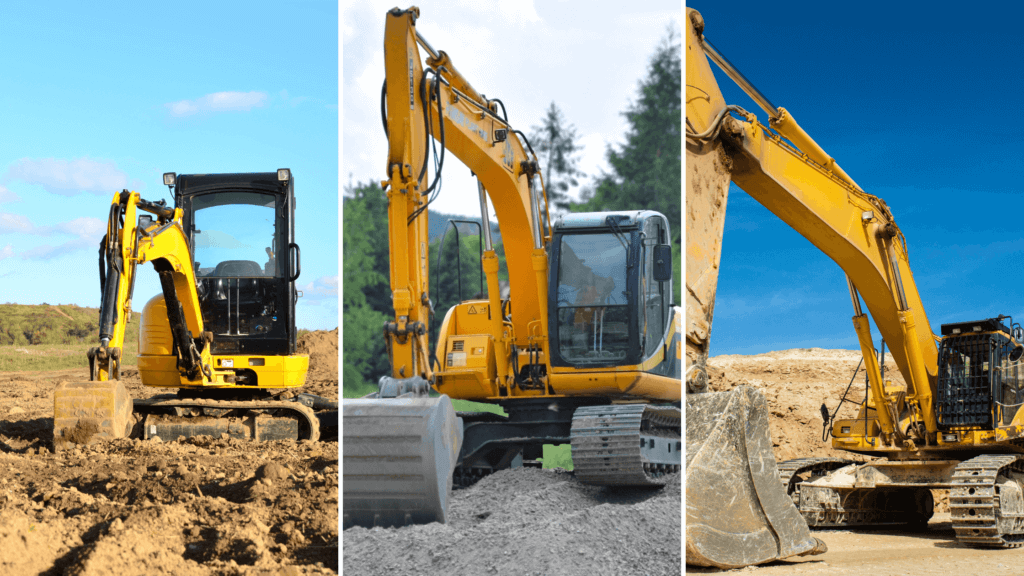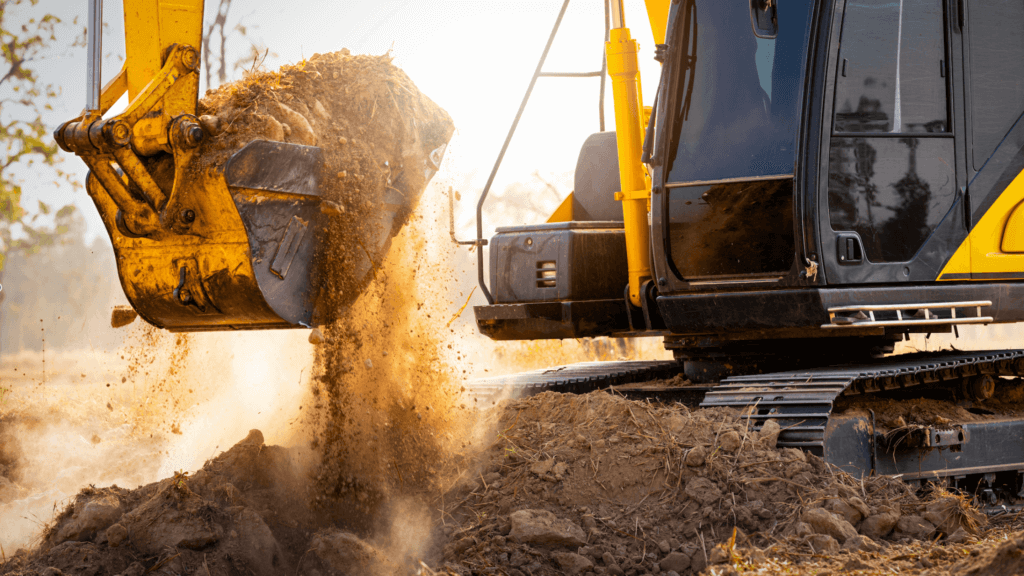Excavators are the backbone of construction, demolition, and excavation projects. With their versatility and power, these machines can tackle anything from precision work in tight spaces to heavy-duty digging and lifting on massive job sites. But with so many sizes, configurations, and features, finding the right excavator for your needs can feel overwhelming. To help you determine whether you need a compact model that can fit into tight spaces or a large excavator to take on your biggest jobs, consider factors including size and weight class, tail swing, project size and scope, and what kind of power and performance you need to do the job.
Quick look
- Mini/compact excavators generally weigh up to 13,500 lbs and work well in compact spaces.
- Midi excavators weigh between 16,000 and 22,000 lbs and offer more power than the mini models while being reasonably agile.
- Standard excavators usually weigh between 22,000 and 100,000 lbs and are the most popular size. These are the machines you’ll find on most construction sites.
- Large excavators weigh over 100,000 lbs and are used in large-scale demolition and construction projects.
- To help choose the right excavator, consider factors like size and weight class, tail swing, project size and scope, arm configurations, comfort features, and worksite conditions.
Types of excavators

Mini or compact
- Weight: Up to 13,000 lbs
- Best for: Smaller jobs in tight spaces
These are the go-to excavators for jobs in tight spaces that require maneuverability and agility. Both compact and mini excavators are small, but compact excavators are heavier and can handle a bigger load. Mini and compact models are also the most portable; you can load them onto a trailer and tow them behind a truck to move them easily between job sites.
Of course, the smaller models’ maneuverability and portability come at a price. Mini and compact excavators have a shallower digging depth, less lifting capacity, and shorter reach than larger excavators.
Midi
- Weight: 16,000 to 22,000 lbs
- Best for: A balance of power and maneuverability
Midi excavators exist within the Goldilocks zone, small enough to operate within smaller spaces and work in residential environments while also having more power, weight capacity, and digging depth than compact models.
Standard
- Weight: 22,000 to 100,000 lbs
- Best for: Most construction sites
This is a full-size excavator capable of handling most heavy-duty tasks. It’s the most popular excavator class and the one you’ll find operating on most construction sites. Standard-sized excavators offer more power and reach than midi models, and the addition of hydraulic systems provides them with greater power and lift capacities.
Large
- Weight: Over 100,000 lbs
- Best for: Big jobs and demolition duty
This is the granddaddy of excavators, the big guns, the Clydesdale workhorses of the construction world. Large excavators are the machines you want for bigger demolition jobs and massive construction tasks, but you won’t see these machines in city environments due to their size. The immense power, dig depth, and reach of these large machines require an equally large method of transportation, and you’ll need transport trucks to move them.
What to consider when choosing an excavator

1. Size and weight class
It may be tempting to get the biggest excavator you can afford, but when considering which size and weight class is right for you, consider what jobs you’ll be using the excavator for. When you’re working primarily on smaller-scale construction jobs, in tight areas, or residential applications, the size of larger excavator models will be an impediment, not a TK.
Also, consider how you will move the excavator. If you don’t already own transportation equipment and don’t want to invest in a class 3 truck and larger trailer, stick with the mini/compact model.
2. Tail swing
The excavator’s size isn’t the factor affecting how well it maneuvers. Tail swing refers to how far the excavator cab extends beyond the width of its tracks when it turns. Zero tail swing models offer greater maneuverability in tight spaces because the machine body doesn’t extend past the excavator tracks. If the excavator fits into a space, you’ll be able to rotate fully within it, making it an excellent choice for working in confined spaces. However, zero-swing excavators have reduced operating capacities due to lower counterweights.
Conversely, excavators with a conventional tail swing have an upper machine body that extends past the treads when they turn. These excavators also have larger counterweights, offering more stability and balance.
3. Project size and scope
The size of your project will also impact what excavator is right for you. Consider the projects you’ll be working on and the scope of your excavation needs, then evaluate the excavators according to their dig depths, dump heights, and lift capacities to figure out which one best suits your projects.
While you likely won’t know the scope of every future project, consider the work you’ll most likely be doing with your excavator to determine how much reach, digging power, and hydraulic lift you might need, and then choose your excavator accordingly.
4. Arm configurations
If you work in conditions requiring extra-long reach or dig depth, you’ll want to choose an excavator with a long-arm option. A longer arm allows the excavator to reach higher dump heights and dig further into the ground. It also has a counterweight to stabilize the machine during this added reach.
5. Worksite conditions
The environment in which the excavator will be used will affect the size you’ll need. Picture the worksite where the excavator will operate and imagine how it’ll move around within the construction zone, any obstacles to maneuver past or through, and how it will get to and from the site (if necessary). For a residential area or smaller projects, a mini or compact model is ideal for working around houses, landscaping, and other features. For bigger projects with tight clearance, a zero-swing model might be necessary.
6. Power and performance
Weighing your power and performance requirements will help you choose the correct excavator. Smaller excavator models will have less digging force and lift capacity than midsize excavators but perform better in tight spaces. Large models have the power to get through just about any job, but their cost and fuel requirements mean a lower return on investment if you aren’t using them to their full potential.
7. Comfort features
Comfort might not be at the top of your mind when choosing an excavator, but if you’re planning on working full day behind the controls, features like a shock-absorbing seat, air conditioning, smart controls, and other options become almost as important as the more technical specs. Choose an excavator with enough comfort features to help you focus and feel good while getting the job done.
Quick tips for picking the right excavator
- Consider options and add-ons. Many excavators have additional tools, accessories, and optional features that can extend their use and function. Check which ones are available for the models you’re considering and how they might match your project’s needs.
- Prioritize safety. Excavators are large, heavy machines—even the mini models can cause damage, accidents, and injuries if misused. Safety features like seatbelts, hydraulic safety interlocks, swing protection, backup cameras, and alarms can help reduce the risk of accidents.
- Look for tech integration. Technology can offer crucial insight into excavator performance and site conditions and provide features like GPS, auto-idling, sensors, and even AI-powered tech to improve excavator operations and offer precision control.
Bottom line
Choosing the right excavator is about more than just picking the biggest machine on the lot. It’s about understanding your project’s demands, the site conditions, and the excavator’s features. Whether you need the maneuverability of a mini excavator or the muscle of a large one, considering factors like tail swing, power, and worksite logistics ensures you invest in equipment that gets the job done efficiently and safely. With the right excavator in your fleet, no job is too big or too small.
For all the best gear reviews and equipment guides, subscribe to our newsletter and follow us on social media!



1 comment